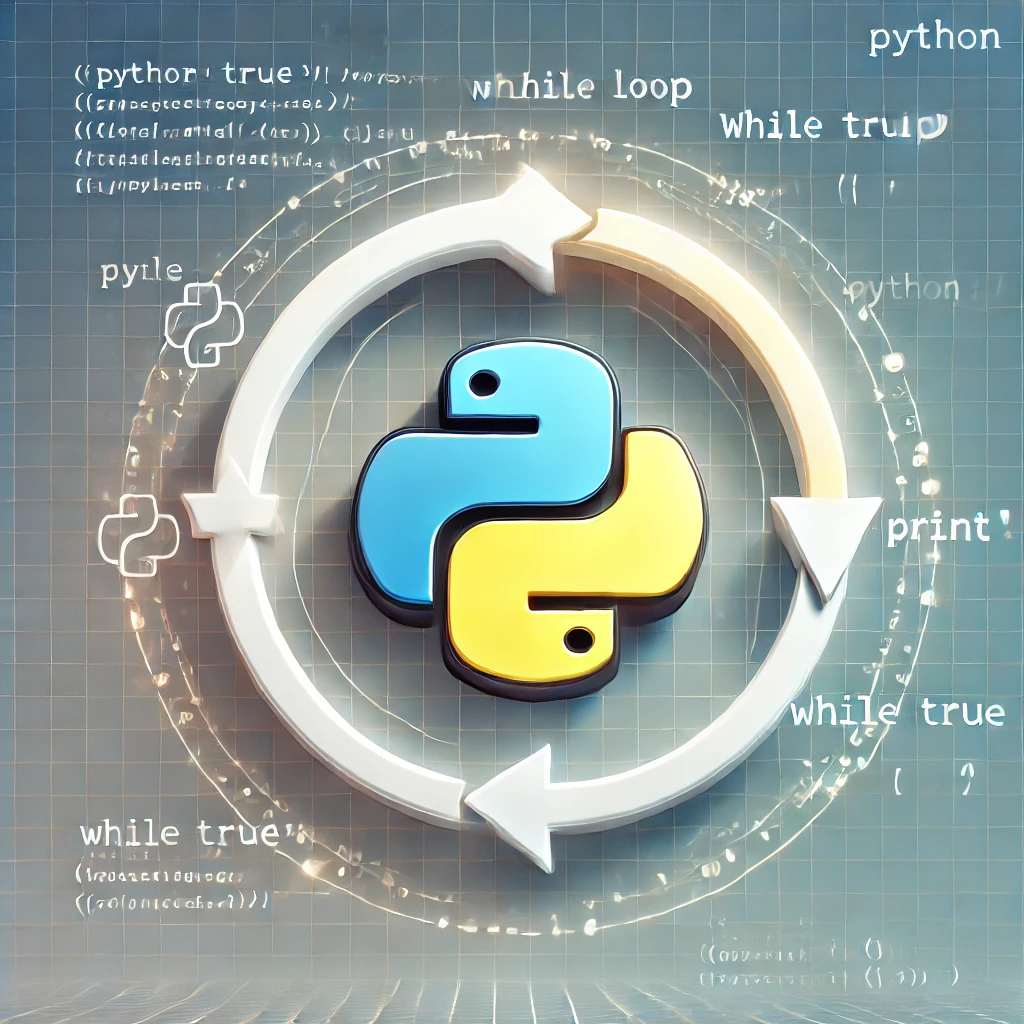In Python, loops play a crucial role in automating repetitive tasks and making programs more efficient. One of the most commonly used loops is the while loop, which continues to execute a block of code as long as a specified condition remains true. Understanding the workings of the while loop is fundamental for any Python programmer, from beginners to experts.
In this article, we’ll delve deep into the while loop in Python programming, covering its syntax, usage, variations, and common pitfalls. By the end, you’ll have a solid understanding of how to use the while loop to enhance the functionality of your Python programs.
1. What is a While Loop in Python?
A while loop in Python is a control flow statement that allows code to be executed repeatedly based on a condition. Unlike the for loop, which runs a set number of times, the while loop keeps executing as long as the condition evaluates to True. Once the condition becomes False, the loop terminates.
2. Syntax of the While Loop
The syntax of the while loop in Python is straightforward:
while condition:
# Code block to executeHere, the condition is a Boolean expression that gets evaluated before each iteration of the loop. If it evaluates to True, the code block under the while statement will execute. If it evaluates to False, the loop will terminate.
Example:
count = 1
while count <= 5:
print(count)
count += 1Output:
1
2
3
4
5In this example, the loop runs until count exceeds 5. The loop continues because the condition count <= 5 remains True, but once count becomes 6, the loop exits.
3. The Infinite While Loop
A common issue programmers encounter is creating an infinite loop unintentionally. This happens when the condition never becomes False. While infinite loops can be useful in some scenarios (e.g., running a program that should not terminate unless explicitly told to), they can also lead to system crashes or other issues if not handled properly.
Example of an Infinite Loop:
while True:
print("This is an infinite loop.")In the example above, the loop will never stop executing because the condition is always True. To stop an infinite loop, you’ll need to introduce a mechanism to break out of it, which we will cover later.
4. The Importance of Loop Control
It’s important to ensure that the loop control (i.e., the logic that makes the loop terminate) is properly designed. Failure to update variables that control the condition will result in infinite loops.
In the earlier example where we increment count, it ensures that count eventually reaches a value greater than 5, causing the loop to terminate. Forgetting to increment count would result in an infinite loop.
5. Controlling the While Loop with the Break Statement
The break statement is used to exit a loop prematurely, regardless of whether the condition is still True. It’s useful when you want to stop the loop based on a condition that’s different from the one that governs the while loop.
Example Using Break:
count = 1
while count <= 10:
print(count)
if count == 5:
break
count += 1Output:
1
2
3
4
5In this example, the loop stops once count reaches 5, even though the condition in the while loop (count <= 10) remains True. The break statement forces the loop to terminate.
6. Skipping Iterations with Continue
The continue statement allows you to skip the current iteration and proceed to the next one without terminating the loop entirely. This is useful if you want to ignore certain values or conditions without breaking out of the loop.
Example Using Continue:
count = 0
while count < 10:
count += 1
if count % 2 == 0:
continue
print(count)Output:
1
3
5
7
9In this example, continue skips any even numbers, so only odd numbers are printed.
7. The Else Clause in While Loops
Python also allows you to use an else clause with while loops. The else clause is executed after the loop finishes its iterations, but only if the loop wasn’t terminated by a break statement.
Example with Else:
count = 1
while count <= 5:
print(count)
count += 1
else:
print("Loop finished without break.")Output:
1
2
3
4
5
Loop finished without break.In this case, the else block is executed because the loop completes normally. If there was a break statement inside the loop that caused it to terminate prematurely, the else clause would not execute.
8. Using While Loops for Input Validation
A common use of while loops is for input validation. You can keep asking the user for input until they provide valid data.
Example of Input Validation:
age = input("Enter your age: ")
while not age.isdigit():
print("Please enter a valid number.")
age = input("Enter your age: ")
print(f"Your age is {age}.")In this example, the program will keep asking for a valid number until the user enters one.
9. Nested While Loops
Like other loops, while loops can be nested. That means you can have a while loop inside another while loop. This is often used for more complex scenarios like working with multi-dimensional data structures.
Example of a Nested While Loop:
i = 1
while i <= 3:
j = 1
while j <= 3:
print(f"i = {i}, j = {j}")
j += 1
i += 1Output:
i = 1, j = 1
i = 1, j = 2
i = 1, j = 3
i = 2, j = 1
i = 2, j = 2
i = 2, j = 3
i = 3, j = 1
i = 3, j = 2
i = 3, j = 3In this example, the outer loop controls the variable i, while the inner loop controls j. Both loops run three times each, creating a grid of output values.
10. Avoiding Common Mistakes with While Loops
When working with while loops, there are several common mistakes to be aware of:
- Forgetting to update the loop control variable: As seen earlier, failing to modify the condition (e.g., incrementing a counter) can lead to infinite loops.
- Misplacing the condition: Ensure that the loop’s condition is evaluated correctly and consistently.
- Using inappropriate break conditions: Ensure that you have a logical reason for using
break, and don’t misuse it in a way that causes unintended behavior.
11. Practical Applications of While Loops
While loops are essential in various programming scenarios:
- Waiting for User Input: For applications that require interaction with a user, the
whileloop can keep the program running until a specific action is taken. - Game Development: Many video games rely on an infinite loop to keep the game running until the user quits.
- Automation Tasks: Scripts that monitor a server or repeat tasks, like checking for certain conditions in data processing, often use
whileloops.
12. Performance Considerations
While loops can be resource-intensive if not handled properly. Running an infinite loop unintentionally can consume significant CPU resources. Always ensure the condition is manageable and that the loop has a clear exit strategy.
Conclusion
The while loop is a powerful and flexible tool in Python programming that allows for repeated execution of code as long as a specific condition is met. By mastering the while loop, you’ll be able to write more dynamic and efficient Python programs, handle repetitive tasks with ease, and ensure your code runs smoothly.
In this article, we explored various aspects of the while loop, from its basic syntax to advanced use cases like nested loops and input validation. Armed with this knowledge, you’re well-equipped to integrate while loops effectively into your Python projects.
FAQs
- What is the difference between a
whileloop and aforloop?
Awhileloop runs based on a condition, while aforloop runs for a specified number of iterations. - Can a
whileloop become an infinite loop?
Yes, if the loop’s condition is alwaysTrueand there is no mechanism to break out of the loop. - When should I use a
whileloop instead of aforloop?
Use awhileloop when the number of iterations is not known in advance or when the loop depends on a condition. - How do you exit a
whileloop early?
You can use thebreakstatement to exit awhileloop before the condition becomesFalse. - Can
whileloops be nested?
Yes, you can place onewhileloop inside another for more complex iterations. - What happens if the condition in the
whileloop isFalseat the beginning?
The loop will not execute even once if the condition isFalseat the outset.


Leave a Reply